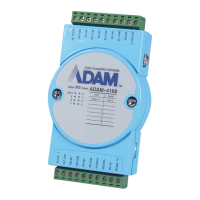RS-485 Network
E-
2
ADAM 4100 Series User’s Manual
EIA RS-485 is industry’s most widely used bidirectional, balanced
transmission line standard. It is specifically developed for industrial
multi-drop systems that should be able to transmit and receive data at
high rates or over long distances.
The specifications of the EIA RS-485 protocol are as follows:
-Max line length per segment: 1200 meters (4000 feet)
-Throughput of 10 Mbaud and beyond
-Differential transmission (balanced lines) with high resistance against
noise
-Maximum of 32 nodes per segment
-Bi-directional master-slave communication over a single set of twisted
pair cables
-Parallel connected nodes, multi-drop capability
ADAM modules are fully isolated, and they use just a single set of
twisted pair wires to send and receive! Since the nodes are connected
in parallel, they can be disconnected from the host without affecting the
performance of the remaining nodes. For industrial use, shielded
twisted pair is preferred due to the high noise ratio of the environment.
When nodes communicate through the network, no conflicts during the
transmission will occur since only a simple command/response
sequence is used. There is always one initiator (with no address) and
many slaves (with address). In this case, the master is a personal
computer that is connected through its serial RS-232 port to an ADAM
RS-232/RS-485 converter. The slaves are the ADAM I/O modules.
When modules are not transmitting data, they are in listening mode.
The host computer initiates a command/response sequence with one of
the modules. Commands normally contain the address of the module
that the host wants to communicate with. The module will respond back
to the host once a match is occurred between the module and the
command.

